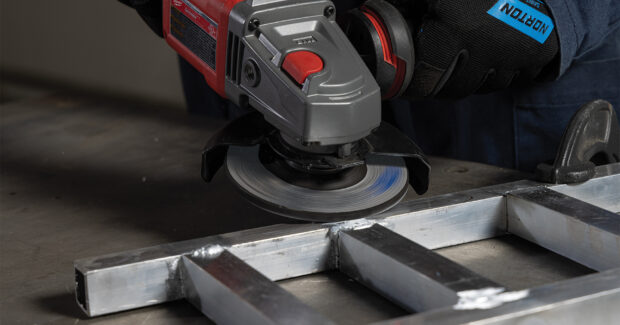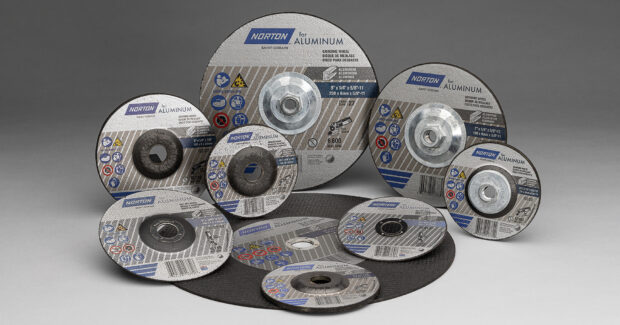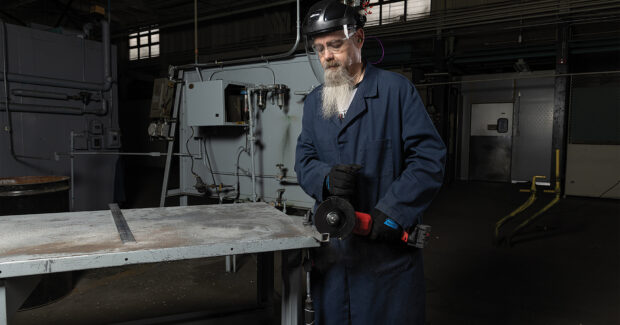How to Optimize Aluminum Grinding and Cutting
A perspective on aluminum’s growing role in our world and why it is important to know your abrasives options and how to apply them.
Posted: July 22, 2023
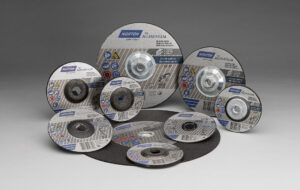
As industries strive to achieve higher efficiencies, reduce emissions, and maximize savings, the use of aluminum is increasing as a replacement for carbon steel and other alloys. The benefits of using aluminum are most evident in industries such as automotive, aerospace and transportation, which greatly benefit from its energy-efficient performance and strength-to-weight ratio. Also, for applications in which structural integrity is a top requirement, such as construction or scaffolding, aluminum is the obvious choice due to its light weight and high resistance to shape stress. Aluminum is used in an extensive range of products including the construction of solar panels, wind turbines, power lines, roofing, and window assembly systems.
Industries such as shipbuilding, marine, offshore, and chemicals prefer the use of aluminum due to its excellent corrosion resistance. Unlike carbon steel, aluminum naturally forms a protective oxide layer that prevents rust without the need for coatings or other surface treatments. This makes aluminum a cost-effective and low-maintenance material, thanks to its longevity and durability.
Aluminum also has great heat and cold resistance properties. It has a high melting point of approximately 660° Celsius (1,220° Fahrenheit). This characteristic allows aluminum to withstand high temperatures without deforming, making it ideal when components are exposed to elevated temperatures. On the other hand, aluminum also demonstrates excellent cold resistance. Its ability to maintain strength and toughness at sub-zero temperatures makes it extremely valuable in industries such as refrigeration, cryogenics and cold storage.
Another characteristic that makes aluminum appealing for industrial applications is its versatility and ease of shaping. It can be formed, welded, machined, ground or extruded, allowing for flexible solutions. Aluminum also requires less finishing preparation after cutting, welding or grinding, as its ability to be coated contributes to its growing popularity. Moreover, the recyclability of aluminum makes it a more sustainable option when replacing steel, alloys, or plastic.
Overall, aluminum’s impressive properties contribute to its wide-ranging applications, enabling its use in diverse industries, opening more opportunities as it continues to be a global trend.
Use the Right Grinding Wheel
Working with aluminum, however, can be tricky. Cutting and grinding aluminum tends to generate heat, causing abrasive wheels to clog up. For example, typical right angle grinder wheels designed for steel are not for use on aluminum because the wheel’s surface can rapidly become clogged with stuck metal chips.
One practice to reduce aluminum metal loading is the application of wax onto a grinding wheel, which delays the onset of metal loading. By applying a slippery substance on the wheel’s surface, it temporarily makes it harder for the aluminum chips to stick. However, as the wheel is used, the wax wears away and will need to be reapplied. This option is not ideal, as wax application takes time away from grinding and creates additional contamination on the workpiece and in the surrounding area that will need to be cleaned up. Also, if the wax is not thoroughly cleaned from the workpiece, it can lead to defects in the weld.
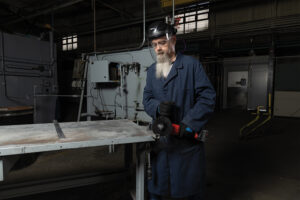
To maintain wheel performance and a steady work rate, it is important to reduce heat generation and let the wheel or tools do the work. To be most efficient, fabricators are well served by using specialized products for preparation, cutting, welding and grinding. Fortunately, there are specialized products such as Norton for Aluminum wheels that make the job easier for both skilled fabricators and occasional users by offering innovative technology to help cut faster, cleaner, and avoid rework when grinding with aluminum.
When cutting and grinding aluminum, basic requirements for a quality result include having an operation which is non-loading, has minimal downtime and avoids extra costs from additives or rework. New wheels are designed to produce less aluminum transfer to the wheel surface, as well as reduced heat sensitivity, so that the wheels can also be used on other non-ferrous materials. The new grinding wheels utilize a special, extra-friable abrasive grain which can fracture and break down just before too much pressure and heat are generated, preventing metal from accumulating.
With a specific focus on right-angle grinder applications, a specialized bond technology in conjunction with the high-quality aluminum oxide grains resists loading and heat generation on the Norton for Aluminum wheel. When heat generation is reduced and material removal rate on the wheel is optimized, wheel life is extended by reducing the load and improving the overall performance.
Due to the wheel construction, users have a much more comfortable grinding experience because the wheels require less energy and pressure to grind. Applying extra pressure will not help the process, and contrary to what the user might expect, it will create extra heat and excess loading, resulting in reduced wheel life. For cutting applications, the Norton for Aluminum free load wheel provides faster and cleaner cuts with long-lasting performance and produces defect-free edges across the aluminum piece.
Users can expect up to 30% greater material removal and an up to 40% faster cut rate when using the Norton for Aluminum wheel compared with other wheels in their class. This produces savings not only on wheels costs, but also savings on process time due to fewer wheel changes and the elimination of additional resources such as wax and cleaners.
{sidebar}
Practical Tips for Grinding Aluminum
It is important to consider several factors to ensure optimal results and minimize potential issues when grinding aluminum:
There is a risk of creating surface damage or scratches on the aluminum. To reduce this risk, it is crucial to control the heat generated during the grinding process. Applying excessive pressure can lead to overheating and the formation of bubble-like defects, which may require additional finishing steps. To mitigate this, reduce the pressure when grinding and allow the abrasive wheel to work freely, reducing heat buildup.
Excessive heat generated during the material removal process can cause distortion or softening of the aluminum, affecting both the workpiece and the abrasive wheels. To prevent damage and achieve effective grinding or cutting, it is recommended to use abrasive wheels with specialized formulations designed for aluminum. These wheels will help dissipate heat efficiently and provide a natural aid for the grinding process.
Contamination is another important consideration because residues from abrasives or grinding aids, as well as metal burrs, can impact the appearance and quality of the aluminum surface. It is essential to select abrasive products that minimize contamination and avoid using waxes or lubricants that may introduce foreign particles. Additionally, it is not advisable to use abrasive wheels previously used on steel, as this can prevent chips or metal burrs from mixing with the aluminum.
Safety should always be a priority when working with abrasives. Personal protective equipment (PPE), such as goggles, gloves, and respiratory protection, should be worn to protect against potential hazards. After using an abrasive wheel, it should be removed from the grinder and stored properly to maintain its integrity and safety for future operations. When working with aluminum, it is crucial to conduct the process in a well-ventilated area and preferably use a vacuum system to prevent aluminum chips from creating sparks.
By considering these factors, one can ensure safer and more effective aluminum grinding, cutting, fabricating and welding operations while preserving the integrity of the material.
Subscribe to learn the latest in manufacturing.


